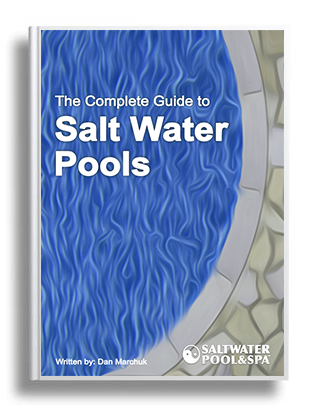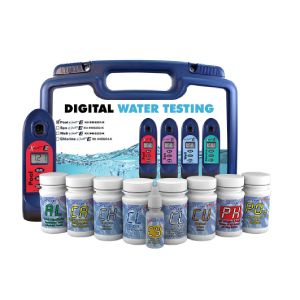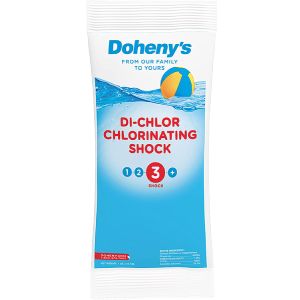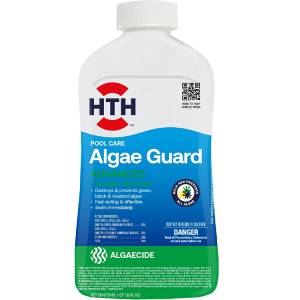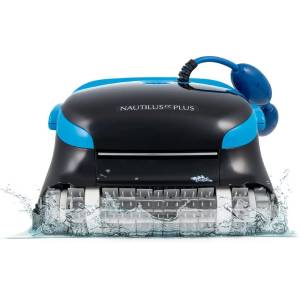Pool Algae Treatment
Pool algae is a living organism that can bloom and multiply turning an entire pool green and nasty in as little as twenty-four hours. Algae spores can get into any pool through rain, wind, leaves or from swimmers that were previously in contaminated water. If you currently have a green and ugly mess caused by algae instead of a sparkling blue swimming pool we can help you get it back to normal by following our how to kill algae guide below.
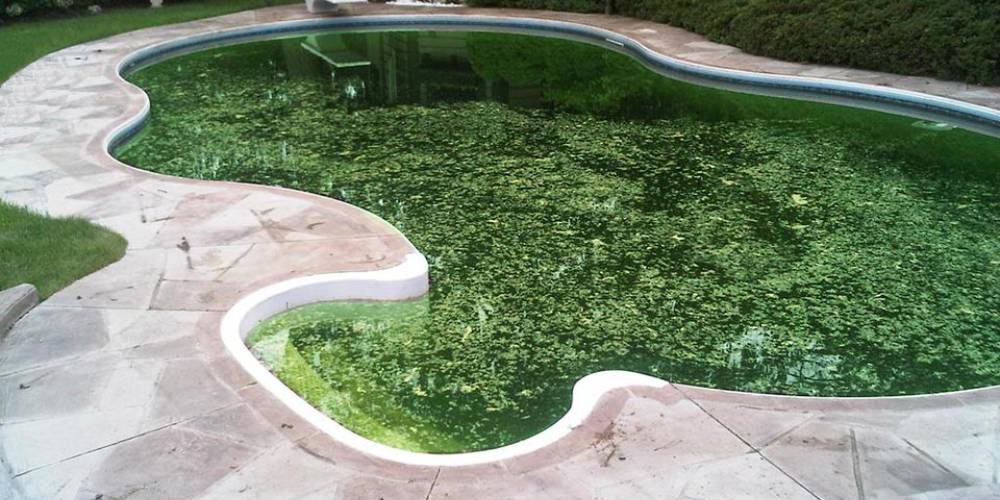
If you have ever experienced green pool water before you will know how frustrating it can be to get your pool back to normal. The good news is that we are going to explain how to eliminate algae and get your pool looking crystal clear as well as some preventative tips for owners that have algae that keeps coming back. If you are a salt water pool owner the likelihood of experiencing pool algae is significantly lower because salt is a natural deterrent.
The Complete Guide to Salt Water Pool MaintenanceEverything you need to know to maintain your salt water pool and keep it running smoothly all season. |
|
Types of Pool Algae
If you have algae in your pool right now the first step is to identify what kind you are dealing with so you can get rid of it effectively. The remedies vary so it is important to spend some time to learn about the different types of pool algae and after you have a good idea of the culprit you can work through the steps below that explain how to get deal with each kind.
Green Pool Algae
This is the most common type but on the bright side it's also the easiest to kill. It can be found floating freely in your pool creating very distinct green pool water. It can also be found growing on pool walls, on the bottom of your pool or in crevices. It can drastically reduce water clarity and will often form during periods of inadequate circulation and poor water chemistry.
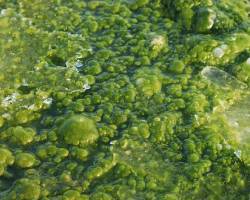
Yellow Pool Algae
Yellow colored spores are often referred to as mustard algae. It is often mistaken as yellow stains and can be confusing because it looks like sand or dirt lying on the bottom of the pool. If you have this organism in your pool you will be in for a bit of a battle but there are some great products designed specifically to kill it as well as prevent it in the future.
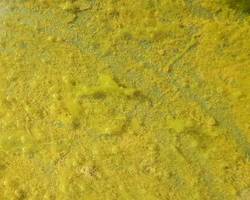
Black Pool Algae
The hardest to get rid of is black algae because of it's deep roots and ability to defend itself against sanitizers. It is very uncommon but when it does form it will likely be found on the walls and in corners of plaster pools growing in small black patches. If you have tile you may find it growing along the grout lines where it can sink its roots and take hold.
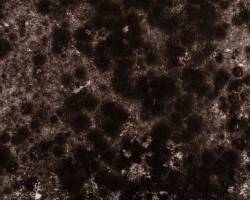
Pink Pool Algae
Pink algae can appear in small areas either in crevices or corners behind pool hardware where circulation is limited. It is a slimy pinkish-red substance that is actually a bacteria and looks like rust on your pool walls. It is different than black algae in that it likes to form on smooth surfaces where brushing is infrequent.
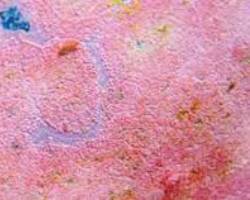
How to Get Rid of Pool Algae
After you have determined which type of algae you have in your pool it's time to put together a plan to eliminate and prevent it from coming back. The methods for getting rid of the different types of algae are roughly the same it's just a matter or using a higher concentration depending on how severe the outbreak appears. The following steps will explain how to get rid of green algae and mustard algae because they are by far the most common.
- Balance pool water
- Brush pool wall or liner
- Use a pool shock
- Superchlorinate
- Use a flocculant
- Use an algaecide
- Test the water chemistry
- Vacuum the pool
- Clean the filter
- Prevent algae growth
1. Balance Pool Water
The fact that you have algae in your pool is most likely due to poor water chemistry and should be the first thing you address. If you don't have a good quality pool water test kit you will need one to get accurate readings so you know what to adjust. If you don't feel comfortable testing on your own you can take a water sample to a local pool dealer.
The pH level between 7.2 and 7.6 is the most important because it will allow the chlorine to work most effectively within this range. Keep in mind that a high pH level may have been a contributing factor to your initial algae outbreak. You will also want to make sure that your other levels are within recommended range including alkalinity and sanitizer and if you want more detailed information you can check our page on pool maintenance.
ITS Complete Pool Test Kit with 10 Testing ParametersDigital pool testing kit for complete water chemistry management. If you click on this link and make a purchase, we may earn a commission. |
2. Brush Pool Wall or Liner
A thorough brushing is important because it will loosen up and disturb algae that has made its home in your pool, making it easier to kill. It will be the most labour intensive part but worth every minute because you want to make sure that the algae never comes back. You should pay special attention to areas behind steps, ladders and hidden crevices where it likes to hide.
If you have a vinyl liner you should use a nylon brush and for concrete you should use a steel brush. You may also want to use a pumice stone to get the really stubborn algae especially if you are dealing with black algae in a concrete pool. If you would like more related information on cleaning be sure to read about pool tile cleaner. With mustard algae and black algae it's very important to brush vigorously and removed as much of the spores as possible.
3. Use a Pool Shock
A pool shock is designed to kill bacteria and pool algae by raising chlorine levels up temporarily. The most common shock contains calcium hypochlorite but you may find that shock containing lithium hypochlorite, di-chlor and potassium peroxymonosulfate are better for your pool. They all get the job done but as a pool owner you should know the differences and how they will affect the chemistry of your pool in the long run.
Doheny's Chlorine Di-Chlor Pool Shock Water TreatmentIf you click on this link and make a purchase, we may earn a commission. |
- Light green algae; 2 pounds of shock for every 10,000 gallons
- Medium green algae; 4 pounds of shock for every 10,000 gallons
- Dark green algae; 6 pounds of shock for every 10,000 gallons
- Black algae; 8 pounds of shock for every 10,000 gallons
- Yellow algae; use a product called Yellow Out
4. Super Chlorinate
If you are a salt water pool owner you may be familiar with super chlorinate if your chlorine generator has this feature. The superchlorinate function provides a temporary increase or boost of chlorine production to help prevent and in some cases fight off algae blooms before they get out of hand. It's also a great option at the beginning of the season during pool opening to give the chlorine a boost to fight off organisms that may have flourished.
5. Use a Flocculant
A flocculant or floc is a coagulant that clumps pool algae and other materials into larger groups making it possible to vacuum them from your pool. The clumped algae will collect at the bottom of the pool and needs to be vacuumed out manually to get it out of the pool. This method is a lot of work but it's a fast way to get algae out and your pool looking better. A floc should always be followed up by ensuring chlorine and pH levels are safe.
6. Use an Algaecide
Some algaecides or algicides will kill pool algae and some won't so be sure to check the label before purchasing. They are best used as a preventative measure to kill algae before it blooms and becomes harder to eliminate or in tandem with a shock or floc. You should use quaternary ammonia algaecides called poly-quats just make sure that they don't have foaming agents or metal-based ingredients that can cause staining.
HTH Fast Acting Algaecide for Killing and Preventing AlgaeIf you click on this link and make a purchase, we may earn a commission. |
7. Test the Water Chemistry
After the appropriate shock or combination of shock, floc and algaecide you want to test your water again after it's had a chance to circulate for 24 hours. If the shock was successful you may notice white or grey dead algae suspended which can cause cloudy water. Either way you want to test for chlorine and pH levels to see what is going on in your pool.
- If your chlorine levels are elevated and the algae is still alive you should maintain these levels for the next couple days by adding more shock if necessary.
- If chlorine levels are not significantly higher you may need to shock a second time to elevate levels. If you still see no change in chlorine levels you may need to shock several times or partially drain your pool.
8. Vacuum the Pool
If you notice that algae is still visible after a couple days you may need to brush more vigorously and give your pool a good pool vacuum. If you are maintaining good pool chemistry and you brought chlorine levels high enough with a good shock you should start to see a noticeable difference by day three at the latest.
Once you see that there are no more signs of pool algae it's time to give your pool a very thorough vacuum with a manual vacuum cleaner. This will ensure that you get all the dead algae out of the pool that may have collected at the bottom. You can let your pools circulation and filter deal with the dead algae but this can cause clogging and may take several days to clear up your pool.
Dolphin Nautilus CC Plus Robotic Pool Vacuum CleanerIf you click on this link and make a purchase, we may earn a commission. |
9. Clean Pool Filter
The final step to eradicating pool algae is to give your filter a good clean or backwash if it's a sand pool filter. The last thing you want is the algae to take over your pool again so you want to clean your filter as per the manufacturers instructions. Cleaning the filter will clear the dead algae out that may block filtration and will also help prevent algae from spreading again. If you have a salt water pool, we recommend also cleaning the pool cell with muriatic acid.
10. Prevent Algae Growth
If you spent time, money and possibly some sweat and tears getting your pool free from algae you will probably be motivated to prevent pool algae from growing in your pool again. Just like everything else it's definitely worth putting in a bit of preventive effort in now to avoid bigger headaches down the road.
Every pool is different and you should be aware of the factors that could possibly put you at a higher risk of developing algae:
- Poor water quality including improper levels of sanitizer (chlorine), pH and alkalinity.
- Poor circulation caused by inadequate run times, ineffective filter, underpowered pump or clogged plumbing and jets.
- Poor maintenance routine including brushing and vacuuming.
- Hot and sunny weather over an extended period.
It goes without saying that water quality is the most important thing when it comes to maintaining a healthy pool. If you stay on top of chemistry in your pool water you should never have an algae problem. If you are someone that likes added peace of mind you might consider using an algaecide every week that isn't metal based or cause foaming.
If you suspect that circulation is the issue you should start with assessing the performance of your pump. A pump should turn over the water in your pool twice every day to ensure adequate filtration and in the case of a chlorine generator it's even more important. Plumbing and jets should all be inspected to ensure that there are no dead spots in your pool that leave areas of stagnant water.
Pool algae likes water that is still and undisturbed and that is why giving your pool a weekly vacuum or brush is such a good deterrent. It can be an automatic or manual vacuum or simply a brush but it's worth taking 10 - 15 minutes a week. While there is no ideal growth temperature for algae it will flourish if conditions are suitable and your pool water is between 60 - 80F (16 - 27C). Hot weather and plenty of sunshine can also cause pool algae spores to multiply through the process of photosynthesis.
Disclaimer
Please use all appropriate and proper safety precautions when attempting projects on this website. All projects are attempted at the reader's own risk.
Salt Water Pool and Spa™ participates in the Amazon Services LLC Associates Program, as an Amazon Associate we may earn a commission from qualifying purchases.
